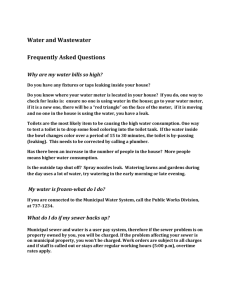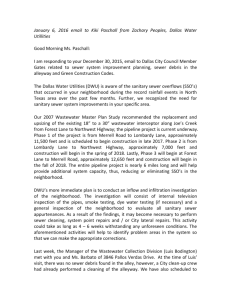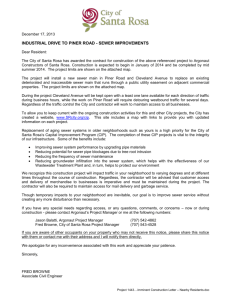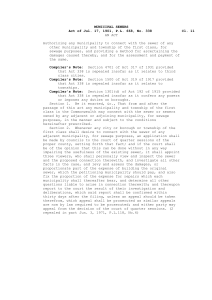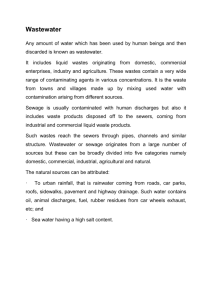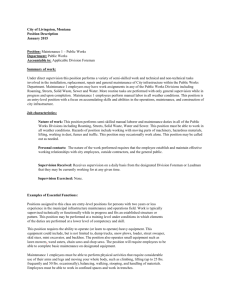docx(eng)14Data
advertisement
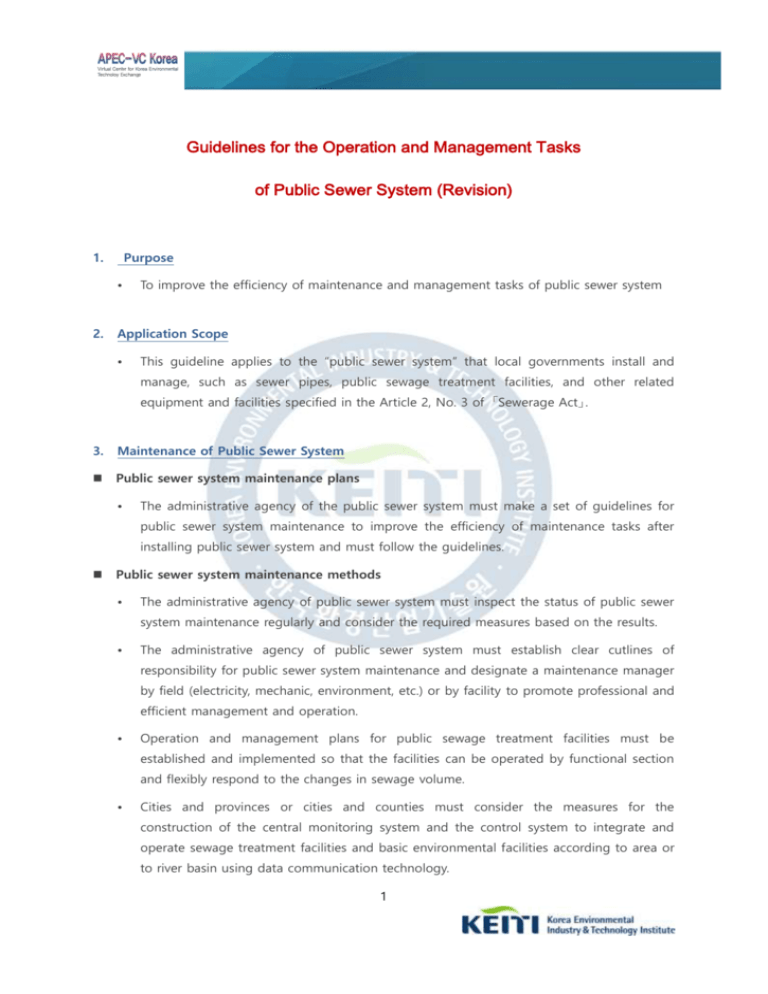
Guidelines for the Operation and Management Tasks of Public Sewer System (Revision) 1. Purpose • 2. To improve the efficiency of maintenance and management tasks of public sewer system Application Scope • This guideline applies to the “public sewer system” that local governments install and manage, such as sewer pipes, public sewage treatment facilities, and other related equipment and facilities specified in the Article 2, No. 3 of 「Sewerage Act」. 3. Maintenance of Public Sewer System Public sewer system maintenance plans • The administrative agency of the public sewer system must make a set of guidelines for public sewer system maintenance to improve the efficiency of maintenance tasks after installing public sewer system and must follow the guidelines. Public sewer system maintenance methods • The administrative agency of public sewer system must inspect the status of public sewer system maintenance regularly and consider the required measures based on the results. • The administrative agency of public sewer system must establish clear cutlines of responsibility for public sewer system maintenance and designate a maintenance manager by field (electricity, mechanic, environment, etc.) or by facility to promote professional and efficient management and operation. • Operation and management plans for public sewage treatment facilities must be established and implemented so that the facilities can be operated by functional section and flexibly respond to the changes in sewage volume. • Cities and provinces or cities and counties must consider the measures for the construction of the central monitoring system and the control system to integrate and operate sewage treatment facilities and basic environmental facilities according to area or to river basin using data communication technology. 1 • The manpower to operate public sewer system must be rationally calculated considering that the basic environmental facilities are integrated and operated by city or by provincial unit. • The administrative agency of public sewer system must establish and implement an annual safety management plan, which includes the following factors below for safety management of the facilities. • To prevent the safety accidents that can occur at sewage treatment facilities, the relevant operating personnel must be quarterly trained in line with the safety and provision of solutions in case of emergency, and the education and training shall include the following below. • The administrative agency of public sewer system must consider the measures for Combined Sewer Overflows (CSOS). • Because sewage treatment facilities are classified as odor emission facilities in the [attached table No.2] Article 3 of the enforcement regulations of 「Malodor Prevention Act」, the administrative agency of public sewer system must establish a plan for malodor prevention and take the related measures for it, such as installing the odor control facilities to minimize civil complaints by removing malodorous substances. • The 「water quality TMS installation operation tasks manual」can be referred for the efficient maintenance of continuous water quality measuring system. • The administrative agency of public sewer system must make efforts to prevent urban flood damage and drying stream through rainwater outflow reduction and proper drainage for each planning district. • For the combined sewer system areas, the sewage flowing into sewer treatment facilities in excess of the capacity during rainy season must be properly managed. □ Water analysis of public sewage treatment facilities • The samples of influent and effluent of public sewer facilities must be taken based on the followings. • The water quality of influent and effluent must be analyzed. • Necessary measures must be taken, such as installing continuous water quality measuring system or other equipment to analyze pH, BOD, COD, SS, T-N, T-P, etc. 2 Management methods for pretreatments, such as wastewater, night soil, domestic wastewater, leachate • To manage the quality of influent efficiently, the water pollutants from wastewater discharge facilities shall be managed in the following manner. • To manage the quality of influent efficiently, night soil, domestic wastewater, leachate, and food wastewater shall be managed in the following manner. Plans for sludge treatment • The methods for final treatment of sludge is determined after the overall comparison and analysis of mandatory regulations, size of public sewage treatment facilities, volume of sludge, characteristic of area, economics, environment, maintenance, and management. • The plans must be established based on the regulations related to final treatment of sludge. Reuse of the reclaimed wastewater of public sewage treatment facilities • The measures to reuse all the water used to wash public sewage treatment facilities or for the landscape of the facilities must be considered. Promotion of anaerobic digester efficiency improvement projects • Anaerobic digester efficiency improvement projects can be promoted to maximize the operation efficiency of it by reducing the volume of sludge and by increasing by-product gas Countermeasures to manage public sewage treatment facilities against natural disasters • In the case of Combined Sewer Overflows (CSOs) system there is concern that the inflow of sewer would excess the designed volume of sewer. Therefore, the function of the treatment facilities must be kept at best and the by-pass sewer must be minimized to prevent environmental pollution. 4. Guidance and Instruction for Public Sewage System Facilities for guidance and instruction • Public sewage treatment facilities, excreta treatment facilities, and sewer pipes in accordance with the Article 2 of 「Sewerage Act」 Guidance and instruction • The head of environmental local government office must execute regular guidance and instruction for public sewage treatment facilities and excreta treatment facilities. 3 Guidance and instruction methods • The director of guidance and instruction for public sewage facilities is the head of environmental local government office, in principle, but if necessary, joint inspection with relevant experts or mayors of cities and provinces can be executed. • The director of guidance and instruction for excreta treatment facilities is the head of environmental local government office, in principle, but if necessary, joint inspection with relevant experts or the administrative agency of public sewer system. • The related persons of public sewage facilities and excreta treatment facilities must participate during guidance and inspection to secure the fairness. Source : The Ministry of Environment(http://www.me.go.kr) 4

